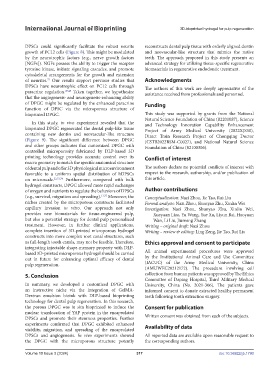Page 325 - IJB-10-3
P. 325
International Journal of Bioprinting 3D-bioprinted hydrogel for pulp regeneration
DPSCs could significantly facilitate the robust neurite reconstructs dental pulp tissue with orderly aligned dentin
growth of PC12 cells (Figure 8). This might be modulated and neovascular-like structure that mimics the native
by the neurotrophic factors (e.g., nerve growth factors teeth. The approach proposed in this study presents an
[NGFs]). NGFs possess the ability to trigger the receptor advanced strategy for utilizing tissue-specific regenerative
tyrosine kinase, initiate signaling cascades, and promote biomaterials in regenerative endodontic treatment.
cytoskeletal arrangements for the growth and extension
of neurites. Our results support previous studies that Acknowledgments
72
DPSCs have neurotrophic effect on PC12 cells through The authors of this work are deeply appreciative of the
paracrine regulation. 47,48 Taken together, we hypothesize assistance received from professionals and personnel.
that the angiogenesis- and neurogenesis-enhancing ability
of DPGC might be regulated by the enhanced paracrine Funding
function of DPSC via the microporous structure of
bioprinted DPGC. This study was supported by grants from the National
Natural Science Foundation of China (82201087), Science
In this study, in vivo experiment revealed that the and Technology Innovation Capability Enhancement
bioprinted DPGC regenerated the dental pulp-like tissue Project of Army Medical University (2022XJS30),
containing new dentin and neovascular-like structure Direct Train Research Project of Chongqing Doctor
(Figure 9). The significant difference between DPGC (CSTB2022BSM-C0027), and National Natural Science
and other groups indicates that customized DPGC with Foundation of China (82100306).
controlled microporosity fabricated by DLP-based 3D
printing technology provides accurate control over its Conflict of interest
macro geometry to match the specific anatomical structure
of dental pulp and offer 3D physiological microenvironment The authors declare no potential conflicts of interest with
favorable to a uniform spatial distribution of hDPSCs respect to the research, authorship, and/or publication of
on microscale. 23,73,74 Furthermore, compared with bulk this article.
hydrogel constructs, DPGC allowed more rapid exchanges
of oxygen and nutrients to regulate the behaviors of DPSCs Author contributions
(e.g., survival, migration and spreading). 11,75 Moreover, the Conceptualization: Nazi Zhou, Jie Tao, Rui Liu
niches created by the microporous constructs facilitated Formal analysis: Nazi Zhou, Shunyao Zhu, Xinlin Wei
capillary invasion in vitro. Our approach not only Investigation: Nazi Zhou, Shunyao Zhu, Xinlin Wei,
provides new biomaterials for tissue-engineered pulp, Xueyuan Liao, Yu Wang, Yue Xu, Liyun Bai, Haoyuan
but also a potential strategy for dental pulp personalized Wan, Li Liu, Jiumeng Zhang
treatment. However, in further clinical applications, Writing – original draft: Nazi Zhou
complete insertion of 3D-printed microporous hydrogel Writing – review & editing: Ling Zeng, Jie Tao, Rui Liu
constructs into more complex root canal structures, such
as full-length tooth canals, may not be feasible. Therefore, Ethics approval and consent to participate
integrating injectable shape-memory property with DLP-
based 3D-printed microporous hydrogel should be carried All animal experimental procedures were approved
out in future for enhancing optimal efficacy of dental by the Institutional Animal Care and Use Committee
pulp regeneration. (IACUC) of the Army Medical University, China
(AMUWEC20212172). The procedure involving cell
5. Conclusion collection from human patients was approved by The Ethics
Committee of Daping Hospital, Third Military Medical
In summary, we developed a customized DPGC with University, China (No. 2021-306). The patients gave
an instructive niche via the integration of GelMA- informed consent to donate extracted healthy permanent
Dextran emulsion bioink with DLP-based bioprinting teeth following tooth extraction surgery.
technology for dental pulp regeneration. In this research,
the porous DPGC was in situ bioprinted to induce the Consent for publication
nuclear translocation of YAP protein in the encapsulated
DPSCs and promote their stemness properties. Further Written consent was obtained from each of the subjects.
experiments confirmed that DPGC exhibited enhanced Availability of data
viability, migration, and spreading of the encapsulated
DPSCs and angiogenesis. In vivo experiments showed All reported data are available upon reasonable request to
the DPGC with the microporous structure potently the corresponding authors.
Volume 10 Issue 3 (2024) 317 doi: 10.36922/ijb.1790

